The AMD Radeon R9 290X Review
by Ryan Smith on October 24, 2013 12:01 AM EST- Posted in
- GPUs
- AMD
- Radeon
- Hawaii
- Radeon 200
Bioshock Infinite
Bioshock Infinite is Irrational Games’ latest entry in the Bioshock franchise. Though it’s based on Unreal Engine 3 – making it our obligatory UE3 game – Irrational had added a number of effects that make the game rather GPU-intensive on its highest settings. As an added bonus it includes a built-in benchmark composed of several scenes, a rarity for UE3 engine games, so we can easily get a good representation of what Bioshock’s performance is like.
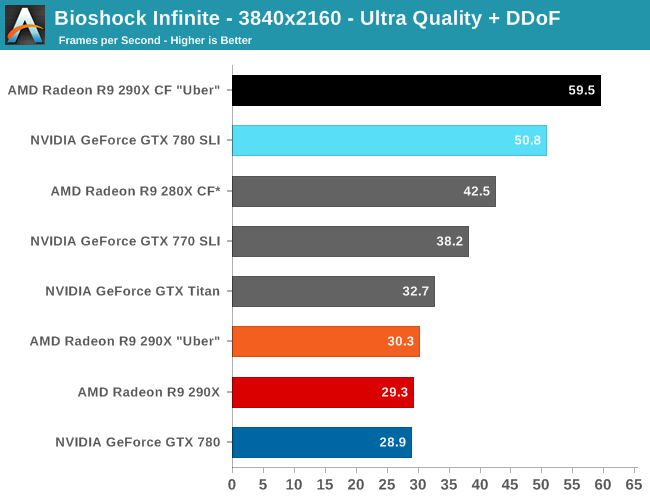

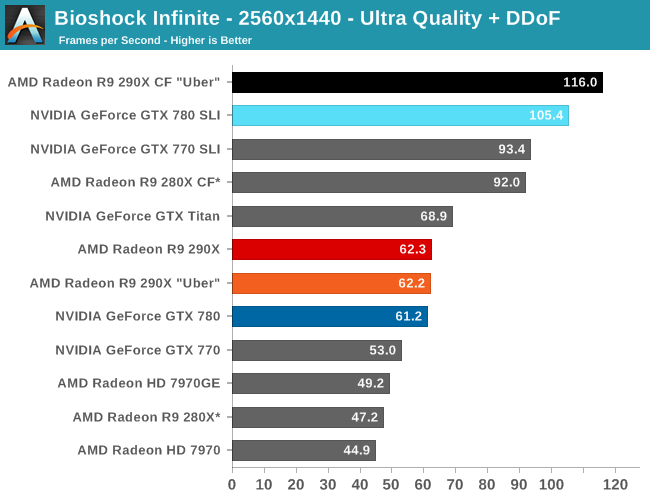
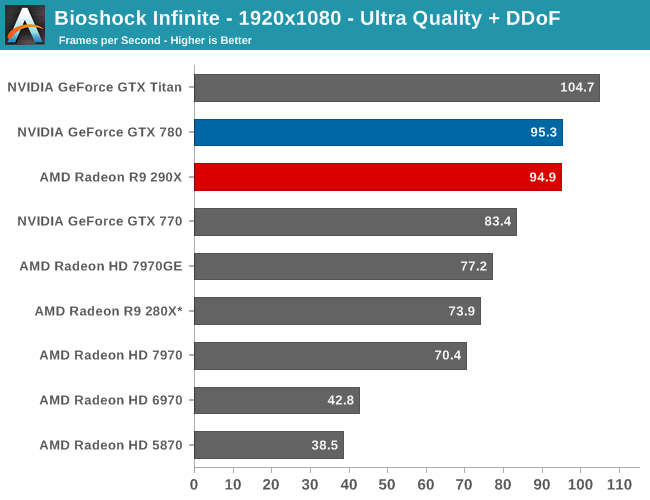
The first of the games AMD allowed us to publish results for, Bioshock is actually a straight up brawl between the 290X and the GTX 780 at 2560. The 290X’s performance advantage here is just 2%, much smaller than the earlier leads it enjoyed and essentially leaving the two cards tied, which also makes this one of the few games that 290X can’t match GTX Titan. At 2560 everything 290X/GTX 780 class or better can beat 60fps despite the heavy computational load of the depth of field effect, so for AMD 290X is the first single-GPU card from them that can pull this off.
Meanwhile at 4K things end up being rather split depending on the resolution we’re looking at. At Ultra quality the 290X and GTX 780 are again tied, but neither is above 30fps. Drop down to Medium quality however and we get framerates above 60fps again, while at the same time the 290X finally pulls away from the GTX 780, beating it by 14% and even edging out GTX Titan. Like so many games we’re looking at today the loss in quality cannot justify the higher resolution, in our opinion, but it presents another scenario where 290X demonstrates superior 4K performance.
For no-compromises 4K gaming we once again turn our gaze towards the 290X CF and GTX 780 SLI, which has AMD doing very well for themselves. While AMD and NVIDIA are nearly tied at the single GPU level – keep in mind we’re in uber mode for CF, so the uber 290X has a slight performance edge in single GPU mode – with multiple GPUs in play AMD sees better scaling from AFR and consequently better overall performance. At 95% the 290X achieves a nearly perfect scaling factor here, while the GTX 780 SLI achieves only 65%. Curiously this is better for AMD and worse for NVIDIA than the scaling factors we see at 2560, which are 86% and 72% respectively.
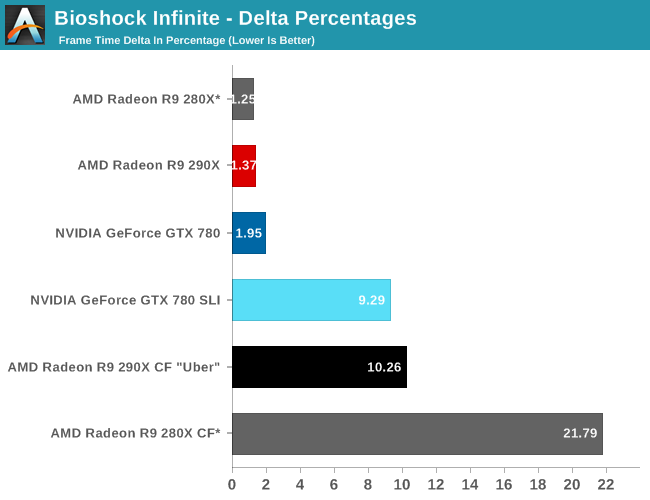

Moving on to our FCAT measurements, it’s interesting to see just how greatly improved the frame pacing is for the 290X versus the 280X, even with the frame pacing fixes in for the 280X. Whereas the 280X has deltas in excess of 21%, the 290X brings those deltas down to 10%, better than halving the variance in this game. Consequently the frame time consistency we’re seeing goes from being acceptable but measurably worse than NVIDIA’s consistency to essentially equal. In fact 10% is outright stunning for a multi-GPU setup, as we rarely achieve frame rates this consistent on those setups.
Finally for 4K gaming our variance increases a bit, but not immensely so. Despite the heavier rendering workload and greater demands on moving these large frames around, the delta percentages keep to 13%.


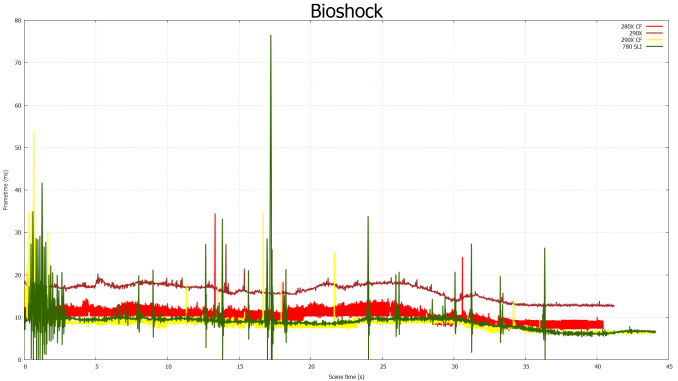









396 Comments
View All Comments
jljaynes - Friday, October 25, 2013 - link
to be fair, he says it's expected to be - he doesn't call out price explicitly.and i am not making this up - i skipped ahead in the video because he was annoying me - and he was still talking about the looks of the card. to me the reviews seem more like an nvidia commercial. i clicked around the entire video - he spends the entire tests talking about specs and thermals.
looncraz - Friday, October 25, 2013 - link
I've read a few reviews and noticed a trend you can verify:While gaming, the 290x only draws about the same amount as the 780, while putting out 10% or better average performance. It is only when you REALLY push the 290x that it draws its highest power - and to do that requires special tweaks from the reviewers, negating reality.
The noise is a problem, the heat is a problem, the performance and power draw really are not. An overclocking a video card is about the dumbest thing ever... yeah, let's risk damaging a $500+ part for an extra 5% higher frame rate... It isn't like a $200 CPU where you go from 3.2GHz to 5GHz...
No, we're talking about going from 1GHz to 1.1GHz.... and spending a premium for better cooling on top of it all...
siliconwizard - Thursday, October 24, 2013 - link
Sure does and an amazing price that is. RIP Titanchizow - Thursday, October 24, 2013 - link
Article chart says $550, Newegg has them in stock now for $580 which may just be BF4 bundle premium: http://www.newegg.com/Product/Product.aspx?Item=N8...Noble07 - Thursday, October 24, 2013 - link
Yup. The bundled version will cost $580. If you look at the newegg page, you'll see is manufacturer has two products up, one with bf4 and one without.patrioteagle07 - Thursday, October 24, 2013 - link
Newegg normally charges $20+ over msrp launch week... MSRP is $549 ...PCboy - Thursday, October 24, 2013 - link
And the Titan is $1000. Just face the facts, Nvidia got rolled.dragonsqrrl - Thursday, October 24, 2013 - link
Rolled? Price drops sir. 8 months on, price drops.tuklap - Thursday, October 24, 2013 - link
but will they drop to the same level as r9 290x? seems to me that 290x is a great buy. take note. that is just the reference performer. What more for the AIB partners ^_^ PRICE DROPS PLEASE!!Shark321 - Thursday, October 24, 2013 - link
Titan is a compute card. In 3 weeks there will be 780Ti for $599, about 5-10% faster than 290X.